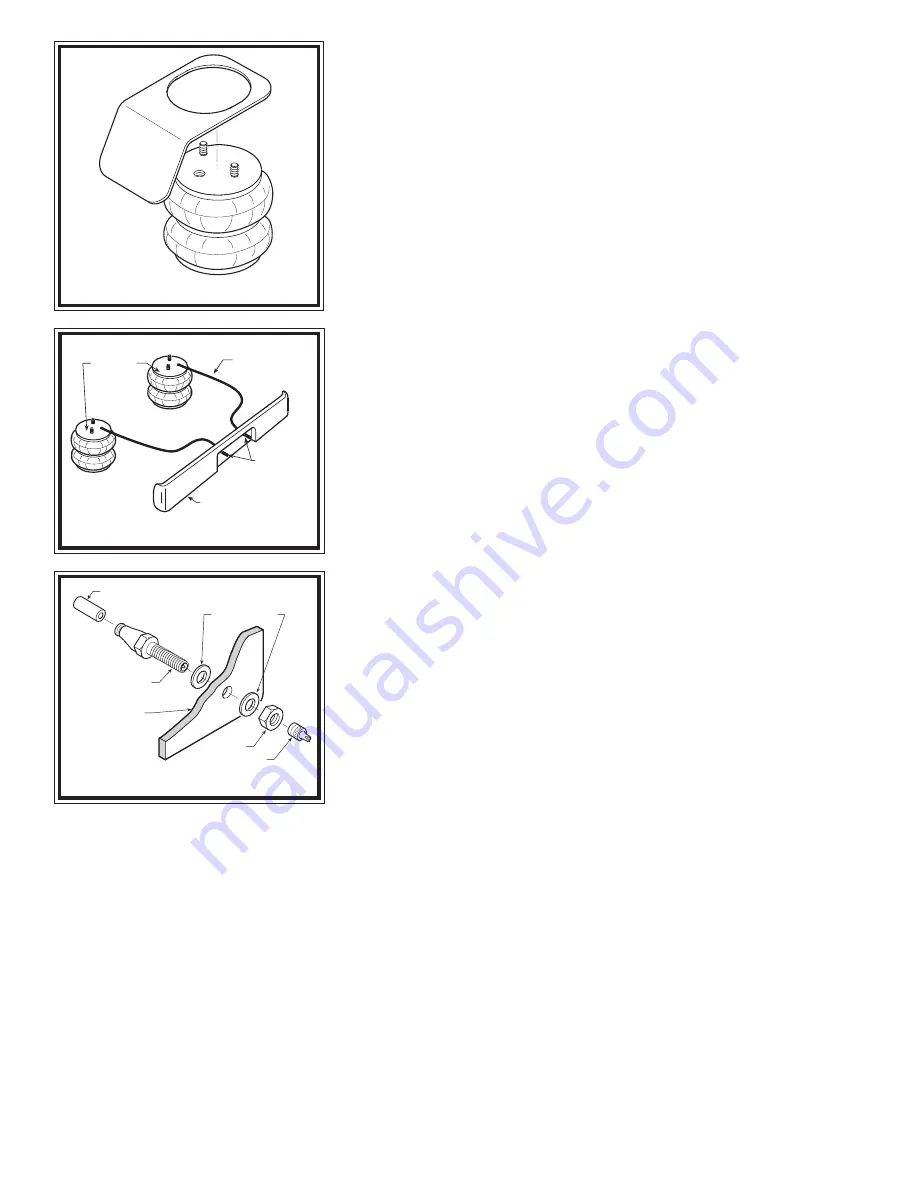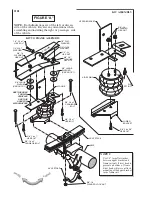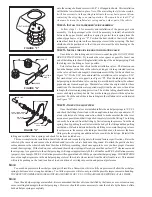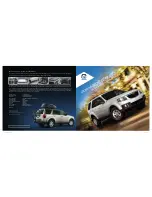
N
OTE
:
Once the air helper springs are installed, it is recommended that the vehicle not be lifted by the frame, as over-extension may
occur, resulting in damage to the air helper springs. However, should it become necessary to raise the vehicle by the frame, deflate
both air helper springs completely.
on to the carriage bolts and secure with 3/8" -16 flanged lock nuts. This installation
will hold the lower bracket in place.
Note: When installing the left-side assembly,
it will be necessary to tie the parking brake line to the sway bar to prevent it from
contacting the air spring in normal operation. There must be at leat 1/2" of
clearance between the inflated air spring and any other part of the vehicle.
S
TEP
4 - I
NSTALL
THE
PASSENGER
'
S
SIDE
ASSEMBLY
Follow steps 1 - 4 for assembly and installation of the passenger's side
assembly. On the passenger's side it will be necessary to install a heat shield
between the upper bracket and the air spring to protect the air spring from the
exhaust pipe heat
see Figure "F".
Position the heat shield so that it will reflect
radiant heat from the point on the exhaust pipe closest to the air spring. The heat
shield should be positioned so that it does not contact the axle housing as the
suspension compresses.
S
TEP
5 - I
NSTALL
THE
AIR
LINE
AND
THE
INFLATION
VALVE
Uncoil the air line tubing and cut it into two equal lengths.
DO NOT FOLD
OR KINK THE TUBING.
Try to make the cut as square as possible. Insert one
end of the tubing into the air fitting installed in the top of the air helper spring. Push
the tubing into the fitting as far as possible.
Select a location on the vehicle for the air inflation valves. The location can
be on the bumper or the body of the vehicle, as long as it is in a protected location
so the valve will not be damaged, but maintain accessibility for the air chuck
see
Figure "G"
. Drill a 5/16" hole and install the air inflation valve using two 5/16"
flat washers per valve as supports
see Figure "H"
. Run the tubing from the air
helper spring to the inflation valve, routing it to avoid direct heat from the exhaust
pipe and away from sharp edges. Thermal sleeves have been provided for these
conditions. If a thermal sleeve is required simply slide the sleeve over the air line
tubing to the location requiring protection. The air line tubing should not be bent
or curved sharply as it may buckle. Secure the tubing in place with the nylon ties
provided. Push the end of the air line tubing into the inflation valve as illustrated
see Figure "H"
.
S
TEP
6 - C
HECK
THE
AIR
SYSTEM
Once the inflation valves are installed inflate the air helper springs to
70 P.S.I.
and check the fittings for air leaks with an applied solution of soap and water. If
a leak is detected at a tubing connection, check to make sure that the tube is cut
as square as possible and that it is pushed completely into the fitting. The tubing
can easily be removed from the fitting by first releasing the pressure from the air
spring, then by pushing the collar towards the body of the fitting and then pulling
out the tube. If a leak is detected where the air fitting screws into the spring, release
the air pressure, then remove the tubing as described above, then screw the brass
fitting into the air spring one additional turn or until the leak stops. Reinstall the
tubing and reinflate the air springs and check for leaks as noted above.
This now completes the installation. Install the wheels and torque the lug nuts to the manufactures specifications. Raise the
vehicle by the rear axle and remove the jack stands and lower the vehicle back onto the ground. Re-attach the positive battery
cable and remove the wheel chocks from the wheels. Before proceeding, check once again to be sure you have proper clearance
around the air springs. With a load on your vehicle and the air helper springs inflated, you must have at least 1/2" clearance around
the air springs. As a general rule, the air helper springs will support approximately 50 lbs. of load for each P.S.I. of inflation pressure
(per pair). For example, 50 P.S.I. of inflation pressure will support a load of 2500 lbs. per pair of air helper springs.
FOR BEST RIDE
use only enough air pressure in the air helper springs to level the vehicle when viewed from the side (front to rear). This amount
will vary depending on the load, location of load, condition of existing suspension and personal preference.
N
OTE
:
Too much air pressure in the air helper springs will result in a firmer ride, while too little air pressure will allow the air helper
spring to bottom out over rough conditions. Too little air pressure will also not provide the possible improvement in handling.
TO PREVENT POSSIBLE DAMAGE MAINTAIN A MINIMUM OF 5 P.S.I. IN THE AIR HELPER SPRINGS AT ALL TIMES.
FIGURE "H"
FIGURE "G"
FIGURE "F"
HEAT SHIELD
AIR HOSE
INFLATION
VALVES
BUMPER
AIR
SPRINGS
AIR LINE
PUSH-TO-CONNECT
INFLATION VALVE
FLAT WASHER
HEX NUT
VALVE CAP
BODY OF
VEHICLE






















